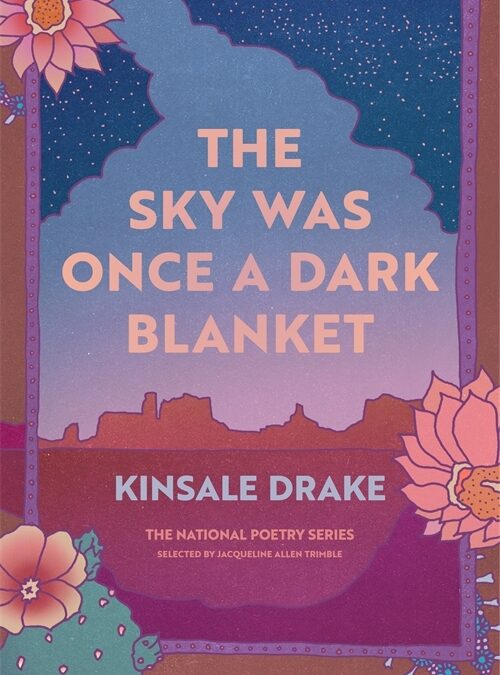The Sky Was Once A Dark Blanket
by Kinsale Drake
The University of Georgia Press, 2024,
80pp, $19.58, paper
As a person who reads the odd poem or two and not an entire book, The Sky Was Once A Dark Blanket by Kinsale Drake was a fun adventure to dive into. Kinsale Drake’s debut book contains 32 poems divided into four sections that explores what it means to be an indigenous person in the twenty-first century.
The first poem you meet isn’t even in the first section. It’s actually the page before section one’s title page. The poem, titled “spangled,” is a fifteen-line poem broken into eight stanzas with two lines each. The poem has a singing base with the words “I must sing” repeating three times. While it isn’t as noticeable in “spangled,” Drake utilizes the space on the page to add another layer of depth to her poems. “Navajo-English Dictionary” is one of the biggest examples of space use. “Navajo-English Dictionary” is a 30-line poem about learning and losing language. Drake didn’t restrict herself to just line breaks and indentations; she also put extra spacing within lines themselves that varies. An example of the different space sizes is line 25,
“rising up the page like song smoke”
The two smaller spaces between “rising” and “up” and “page” and “like” could have been considered as accidental if Drake didn’t pepper them throughout the piece. The more noticeable space between song and smoke is one of the longer spacings in the poem. These spaces act like periods and commas without using them, but still cause the reader to pause for a moment or two. These pauses in addition to the words/phrases in English and Navajo help give Navajo-English Dictionary a jumbled-up feeling. When you are learning or losing a language the word/phrase doesn’t stay still. Instead, they swirl in your mind as you try to recall the word/phrase, but you’ve either lost the word/phrase, momentarily forgotten it, or haven’t even learned it yet. In the language learning perspective, the spaces can give a tone of excitement and eagerness to learn. The words and lines strengthening this perspective include “the words grow” (line 11), “it is about to burst” (line 14) and “Noise beginning at the tip of / The entrance” (lines 21-22). On the other hand, the perspective of losing language gives the spaces a longing, sad and pained tone. The words and lines supporting this perspective include “I am so starved / for words”, “diitaa’—they/it— / fell apart— / went to pieces / shattered” (lines 17-20), “at the tip of / The entrance”, and “Corral the pages inside every half-rainbowed / Consonant” (lines 23-24). In both of these perspectives they showcase the feeling of frustration one gets when learning or losing language using the same words mentioned. You are ravenous for words and try to keep them from slipping past your fingers.
Along with utilizing spacing, Drake also weaves the repetition of music, the color blue, and ghosts in each of the four sections, but not always together. Almost like braiding a two-color bracelet, each colored thread is there forming the bracelet but not alway seen. We see the music thread start in “spangled” then in the first poem of section one titled “August,” a 19-line poem about remembrance, nature and humans. Instead of a singing base like “spangled,” “August” is musical instruments-based with the word ‘instrument’ being repeated four times. Unlike the music thread, blue and ghosts threads are more subtle. The blue thread joins the music one briefly in “FOR MILDRED BAILEY, in three parts,” more specifically, in line 11 of “& Who Remembers Mildred Bailey?” with the line, “Her voice blue smoke” and line 10 of “Kitchen Table, or When Mildred Bailey Sings:” “breaching the shadows of the Blue Angel.” The ghost thread briefly shows up once in section one on line 8 of “Wax Cylinder,” with the line, “of Indian ghosts in the half-light.”
These threads, while not always noticeable or visible in the sections, connect to a larger picture of generational and cultural connection. Mildred Bailey was an indigenous jazz singer in the 1930’s. Music is found in all cultures and age groups. Colors like blue and the idea of ghosts hold different meanings and associations among various cultures and ages. For The Sky Was Once A Dark Blanket, music and ghosts tell the story of the past and current generations of Drake’s family and indigenous people. The color blue, however, is trickier in figuring out its exact connection within The Sky Was Once A Dark Blanket. Blue is often connected with calmness, wisdom and protection, so that is one possibility of what the color blue could mean in The Sky Was Once A Dark Blanket.
All in all, for someone who doesn’t really read poetry books, Drake’s debut book was a delightful read. The spacing and the music, blue and ghosts threads were fun and interesting to explore.
Meet the blogger: Shani Casper is double majoring in English and Communication studies with a concentration in writing, editing and publishing with Creative Writing at Hamline University. She is always carrying a book and writing supplies with her to enjoy whenever she has the opportunity (makes waiting a lot easier). When she isn’t holed up reading or writing you can find her outside or crafting something with art supplies.
Shani Casper is double majoring in English and Communication studies with a concentration in writing, editing and publishing with Creative Writing at Hamline University. She is always carrying a book and writing supplies with her to enjoy whenever she has the opportunity (makes waiting a lot easier). When she isn’t holed up reading or writing you can find her outside or crafting something with art supplies.


